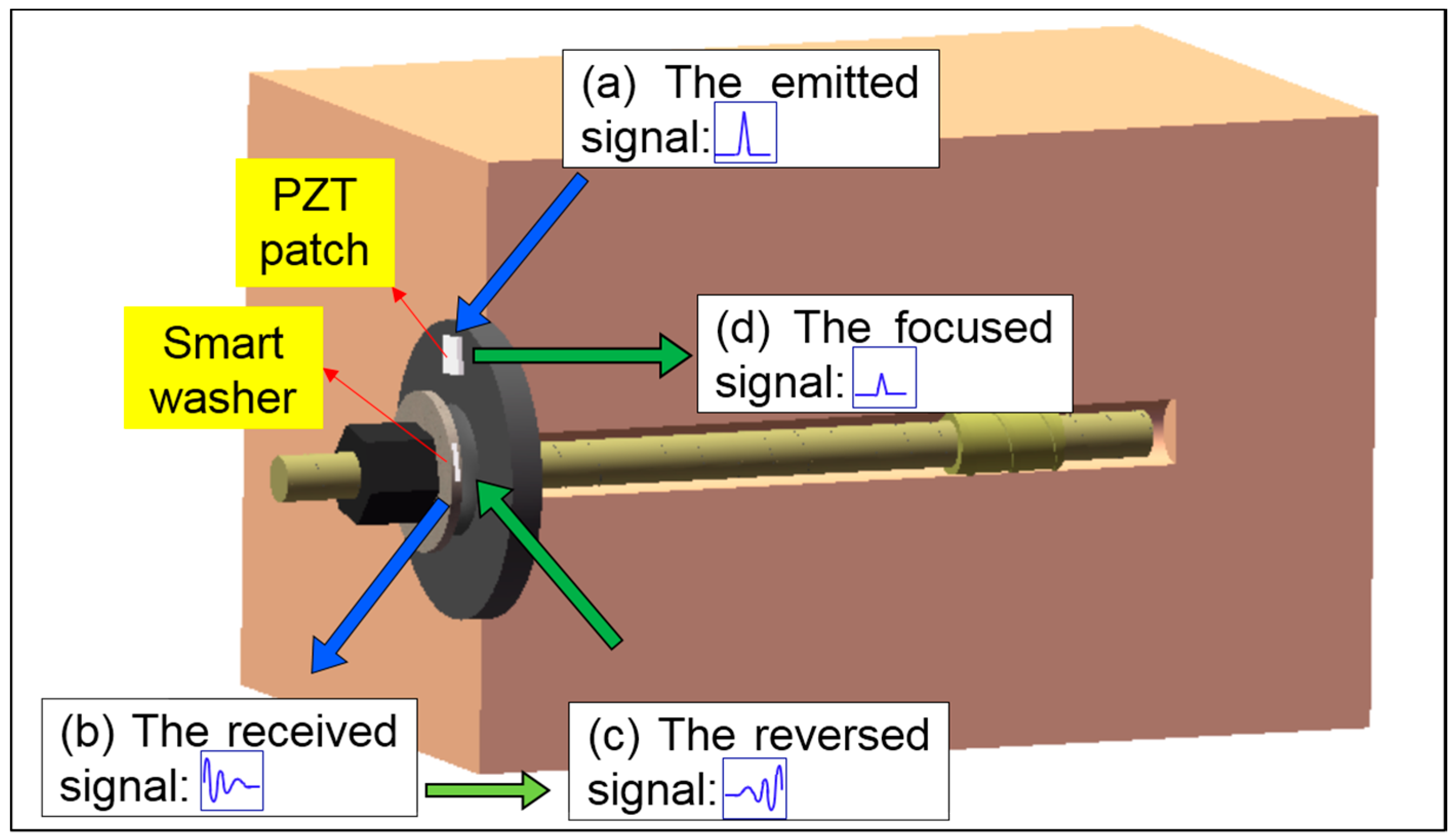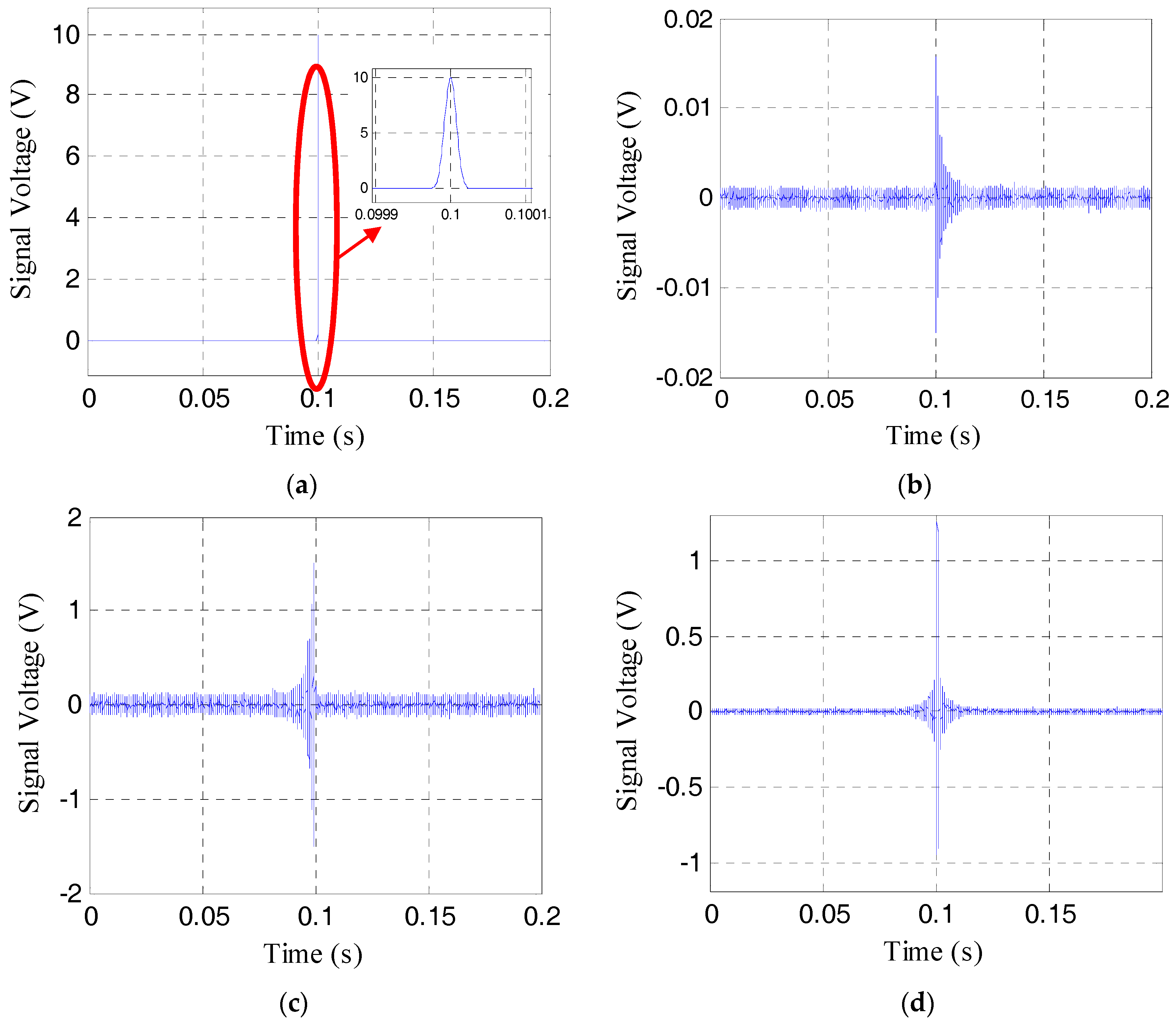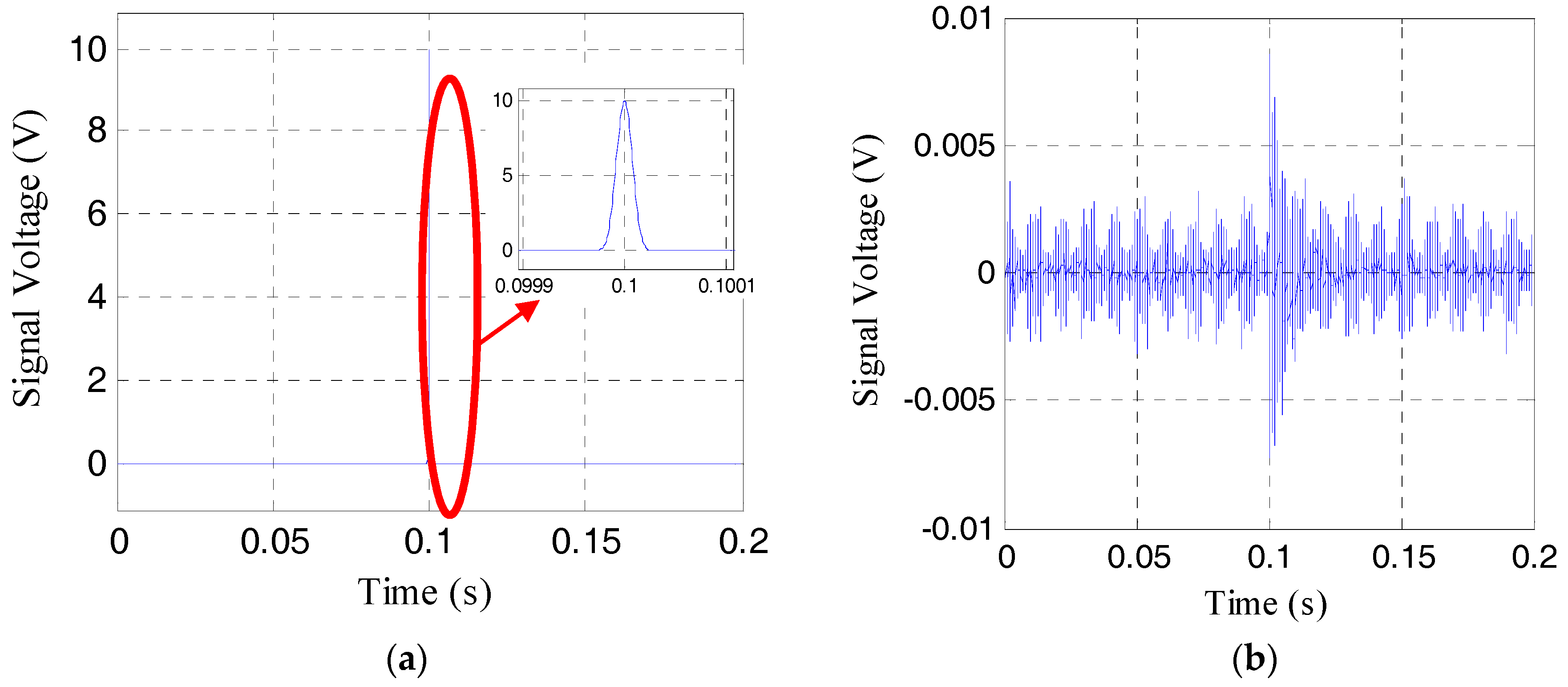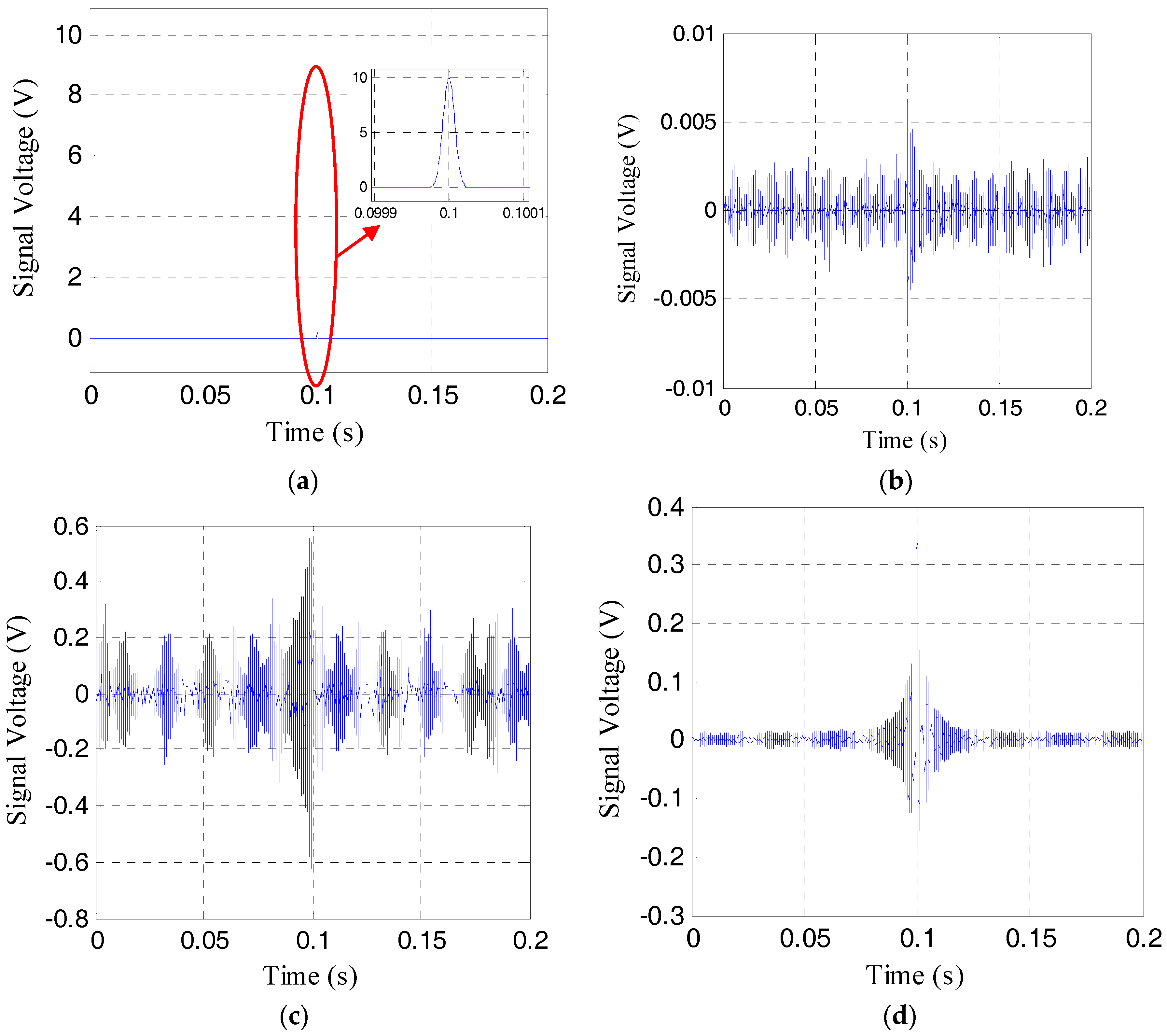Monitoring of Pre-Load on Rock Bolt Using Piezoceramic-Transducer Enabled Time Reversal Method
Abstract
:1. Introduction
2. Principle of Rock Bolt Pre-Load Monitoring Using PZT Enabled Time Reversal Method
3. Experimental Setup and Procedure
4. Experimental Results
5. Discussion
6. Conclusions
Acknowledgment
Author Contributions
Conflicts of Interest
References
- Duzgun, H.S.B. Analysis of roof fall hazards and risk assessment for Zonguldak coal basin underground mines. Int. J. Coal Geol. 2005, 64, 104–115. [Google Scholar] [CrossRef]
- Chen, J.; Qiao, X.; Wang, M. Stress and action mechanism of rock bolt in Loess Tunnel. Chin. J. Rock Mech. Eng. 2011, 30, 1690–1697. [Google Scholar]
- Chou, Y.; Hsin, Y.; Chang, S. Review on recent grave accidents in long tunnel of highway around the world for safety facility. Chin. J. Rock Mech. Eng. 2004, 23, S2. [Google Scholar]
- Yeung, J.S.; Wong, Y.D. Road traffic accidents in Singapore expressway tunnels. Tunn. Undergr. Space Technol. 2013, 38, 534–541. [Google Scholar] [CrossRef]
- Duzgun, H.; Einstein, H. Assessment and management of roof fall risks in underground coal mines. Saf. Sci. 2004, 42, 23–41. [Google Scholar] [CrossRef]
- Kelly, A.; Jager, A. Critically Evaluate Techniques for the in Situ Testing of Steel Tendon Grouting Effectiveness as a Basis for Reducing Fall of Ground Injuries and Fatalities; CSIR: Division of Mining Technology Cape Town, South Africa, October 1996. [Google Scholar]
- Buys, B.J.; Heyns, P.; Loveday, P. Rock bolt condition monitoring using ultrasonic guided waves. J. South. Afr. Inst. Min. Metall. 2009, 109, 95–105. [Google Scholar]
- Craig, P.; Serkan, S.; Hagan, P.; Hebblewhite, B.; Vandermaat, D.; Crosky, A.; Elias, E. Investigations into the corrosive environments contributing to premature failure of Australian coal mine rock bolts. Int. J. Min. Sci. Technol. 2016, 26, 59–64. [Google Scholar] [CrossRef]
- Zhu, H.; Xu, Q.; Ding, W.; Huang, F. Experimental study on the progressive failure and its anchoring effect of weak-broken rock vertical slope. Front. Arch. Civ. Eng. China 2011, 5, 208–224. [Google Scholar] [CrossRef]
- Song, G.; Li, W.; Wang, B.; Ho, S.C.M. A Review of Rock Bolt Monitoring Using Smart Sensors. Sensors 2017, 17, 776. [Google Scholar] [CrossRef] [PubMed]
- Ho, S.C.M.; Li, W.; Wang, B.; Song, G. A load measuring anchor plate for rock bolt using fiber optic sensor. Smart Mater. Struct. 2017, 26, 057003. [Google Scholar] [CrossRef]
- Benmokrane, B.; Chekired, M.; Xu, H. Monitoring behavior of grouted anchors using vibrating-wire gauges. J. Geotech. Eng. 1995, 121, 466–475. [Google Scholar] [CrossRef]
- Nellen, P.M.; Frank, A.; Bronnimann, R.; Sennhauser, U. Optical fiber Bragg gratings for tunnel surveillance. In Proceedings of the SPIE′s 7th Annual International Symposium on Smart Structures and Materials, Newport Beach, CA, USA, 12 June 2000; Volume 3986, pp. 263–270. [Google Scholar]
- Schroeck, M.; Ecke, W.; Graupner, A. Strain Monitoring in Steel Rock Bolts Using FBG Sensor Arrays. In Proceedings of the Symposium on Applied Photonics, Glasgow, UK, 31 August 2000; Volume 4074, pp. 298–304. [Google Scholar]
- Moffat, R.A.; Beltran, J.F.; Herrera, R. Applications of BOTDR fiber optics to the monitoring of underground structures. Geomech. Eng. 2015, 9, 397–414. [Google Scholar] [CrossRef]
- Beard, M.D.; Lowe, M.J.S.; Cawley, P. Ultrasonic guided waves for inspection of grouted tendons and bolts. J. Mater. Civ. Eng. 2003, 15, 212–218. [Google Scholar] [CrossRef]
- Cui, Y.; Zou, D.H. Numerical simulation of attenuation and group velocity of guided ultrasonic wave in grouted rock bolts. J. Appl. Geophys. 2006, 59, 337–344. [Google Scholar] [CrossRef]
- Cui, Y.; Zou, D.H. Assessing the effects of insufficient rebar and missing grout in grouted rock bolts using guided ultrasonic waves. J. Appl. Geophys. 2012, 79, 64–70. [Google Scholar] [CrossRef]
- Madenga, V.; Zou, D.H.; Zhang, C. Effects of curing time and frequency on ultrasonic wave velocity in grouted rock bolts. J. Appl. Geophys. 2006, 59, 79–87. [Google Scholar] [CrossRef]
- He, C.; Van Velsor, J.K.; Lee, C.M.; Rose, J.L. Health monitoring of rock bolts using ultrasonic guided waves. APC Conf. Proc. 2006, 820, 195–201. [Google Scholar]
- Beard, M.D. Guided Wave Inspection of Embedded Cylindrical Structures. Ph.D. Thesis, Department of Mechanical Engineering, Imperial College, London, UK, 2002. [Google Scholar]
- Beard, M.; Lowe, M. Non-destructive testing of rock bolts using guided ultrasonic waves. Int. J. Rock Mech. Min. Sci. 2003, 40, 527–536. [Google Scholar] [CrossRef]
- Pavlakovic, B.; Lowe, M.; Cawley, P. High-frequency low-loss ultrasonic modes in imbedded bars. Trans. Am. Soc. Mech. Eng. J. Appl. Mech. 2001, 68, 67–75. [Google Scholar] [CrossRef]
- Rimasauskiene, R.; Matejka, M.; Ostachowicz, W.; Kurowski, M.; Malinowski, P.; Wandowski, T.; Rimasauskas, M. Experimental research of the synthetic jet generator designs based on actuation of diaphragm with piezoelectric actuator. Mech. Syst. Signal Process. 2015, 50, 607–614. [Google Scholar] [CrossRef]
- Purekar, A.; Pines, D.; Sundararaman, S.; Adams, D. Directional piezoelectric phased array filters for detecting damage in isotropic plates. Smart Mater. Struct. 2004, 13, 838. [Google Scholar] [CrossRef]
- Kim, H.S.; Kim, J.-H.; Kim, J. A review of piezoelectric energy harvesting based on vibration. Int. J. Precis. Eng. Manuf. 2011, 12, 1129–1141. [Google Scholar] [CrossRef]
- Liang, J.; Liao, W.-H. Improved design and analysis of self-powered synchronized switch interface circuit for piezoelectric energy harvesting systems. IEEE Trans. Ind. Electron. 2012, 59, 1950–1960. [Google Scholar] [CrossRef]
- Wang, G. Analysis of bimorph piezoelectric beam energy harvesters using Timoshenko and Euler–Bernoulli beam theory. J. Intell. Mater. Syst. Struct. 2013, 24, 226–239. [Google Scholar] [CrossRef]
- Tsangouri, E.; Karaiskos, G.; Aggelis, D.G.; Deraemaeker, A.; Van Hemelrijck, D. Crack sealing and damage recovery monitoring of a concrete healing system using embedded piezoelectric transducers. Struct. Health Monit. 2015, 14, 462–474. [Google Scholar] [CrossRef]
- Wang, Y.; Zhu, X.; Hao, H.; Ou, J. Guided wave propagation and spectral element method for debonding damage assessment in RC structures. J. Sound Vib. 2009, 324, 751–772. [Google Scholar] [CrossRef]
- Park, S.; Yun, C.-B.; Roh, Y.; Lee, J.-J. PZT-based a ctive damage detection techniques for steel bridge components. Smart Mater. Struct. 2006, 15, 957. [Google Scholar] [CrossRef]
- Zeng, L.; Parvasi, S.M.; Kong, Q.; Huo, L.; Li, M.; Song, G. Bond slip detection of concrete-encased composite structure using shear wave based active sensing approach. Smart Mater. Struct. 2015, 24, 125026. [Google Scholar] [CrossRef]
- Yang, J.; Chang, F.-K. Detection of bolt loosening in C–C composite thermal protection panels: I. Diagnostic principle. Smart Mater. Struct. 2006, 15, 581. [Google Scholar] [CrossRef]
- Yang, J.; Chang, F.-K. Detection of bolt loosening in C–C composite thermal protection panels: II. Experimental verification. Smart Mater. Struct. 2006, 15, 591. [Google Scholar] [CrossRef]
- Wang, T.; Song, G.; Liu, S.; Li, Y.; Xiao, H. Review of bolted connection monitoring. Int. J. Distrib. Sens. Netw. 2013, 9, 871213. [Google Scholar] [CrossRef]
- Wang, T.; Song, G.; Wang, Z.; Li, Y. Proof-of-concept study of monitoring bolt connection status using a piezoelectric based active sensing method. Smart Mater. Struct. 2013, 22, 087001. [Google Scholar] [CrossRef]
- Huo, L.; Chen, D.; Kong, Q.; Li, H.; Song, G. Smart washer—A piezoceramic-based transducer to monitor looseness of bolted connection. Smart Mater. Struct. 2017, 26, 025033. [Google Scholar] [CrossRef]
- Wang, B.; Huo, L.; Chen, D.; Li, W.; Song, G. Impedance-Based Pre-Stress Monitoring of Rock Bolts Using a Piezoceramic-Based Smart Washer—A Feasibility Study. Sensors 2017, 17, 250. [Google Scholar] [CrossRef] [PubMed]
- Fink, M. Time-reversal of ultrasonic fields. 1. Basic principles. IEEE Trans. Ultrason. Ferroelectr. Freq. Control 1992, 39, 555–566. [Google Scholar] [CrossRef] [PubMed]
- Liang, Y.; Li, D.; Kong, Q.; Song, G. Load Monitoring of the Pin-Connected Structure Using Time Reversal Technique and Piezoceramic Transducers-A Feasibility Study. IEEE Sens. J. 2016, 16, 7958–7966. [Google Scholar] [CrossRef]
- Wang, N.; Chen, X.; Song, G.; Lan, Q.; Parsaei, H.R. Design of a New Mobile-Optimized Remote Laboratory Application Architecture for M-Learning. IEEE Trans. Ind. Electron. 2017, 64, 2382–2391. [Google Scholar] [CrossRef]
- Wang, N.; Chen, X.; Song, G.; Parsaei, H. Using Node-HTTP-Proxy for Remote Experiment Data Transmission Traversing Firewall. Int. J. Online Eng. 2015, 11, 2. [Google Scholar] [CrossRef]











| Pre-Load (MPa) | 0 | 1 | 2 | 3 | 6 | 9 | 12 | 15 | 18 | 21 | 24 |
|---|---|---|---|---|---|---|---|---|---|---|---|
| Average value (V) | 0.0495 | 0.3412 | 0.4586 | 0.5673 | 0.6964 | 0.8397 | 0.9669 | 1.0986 | 1.1807 | 1.1568 | 1.1919 |
| Standard deviation (V) | 0.0148 | 0.0761 | 0.0675 | 0.0541 | 0.0817 | 0.1454 | 0.1207 | 0.1105 | 0.1201 | 0.0774 | 0.0668 |
| Pre-Load (MPa) | 27 | 30 | 33 | 36 | 39 | 42 | 45 | 48 | 51 | 54 |
|---|---|---|---|---|---|---|---|---|---|---|
| Average value (V) | 1.1954 | 1.1525 | 1.1130 | 1.1056 | 1.0945 | 1.1109 | 1.1184 | 1.1190 | 1.1129 | 1.1015 |
| Standard deviation (V) | 0.0875 | 0.0664 | 0.0924 | 0.0680 | 0.0517 | 0.0495 | 0.0558 | 0.0496 | 0.0657 | 0.0529 |
© 2017 by the authors. Licensee MDPI, Basel, Switzerland. This article is an open access article distributed under the terms and conditions of the Creative Commons Attribution (CC BY) license (http://creativecommons.org/licenses/by/4.0/).
Share and Cite
Huo, L.; Wang, B.; Chen, D.; Song, G. Monitoring of Pre-Load on Rock Bolt Using Piezoceramic-Transducer Enabled Time Reversal Method. Sensors 2017, 17, 2467. https://doi.org/10.3390/s17112467
Huo L, Wang B, Chen D, Song G. Monitoring of Pre-Load on Rock Bolt Using Piezoceramic-Transducer Enabled Time Reversal Method. Sensors. 2017; 17(11):2467. https://doi.org/10.3390/s17112467
Chicago/Turabian StyleHuo, Linsheng, Bo Wang, Dongdong Chen, and Gangbing Song. 2017. "Monitoring of Pre-Load on Rock Bolt Using Piezoceramic-Transducer Enabled Time Reversal Method" Sensors 17, no. 11: 2467. https://doi.org/10.3390/s17112467






